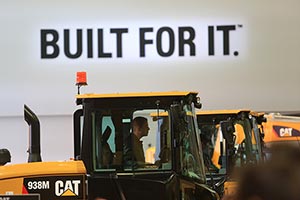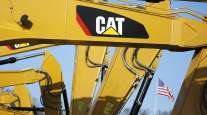Caterpillar Sees Drag From Used Equipment as Miners Bounce Back

Ample used construction-equipment supplies and restrained spending from miners mean the commodities rebound won’t be giving much of a lift to beleaguered Caterpillar Inc., which forecast 2017 results that trailed analysts’ estimates. The shares fell.
The lowered outlook “is happening because business still stinks,” Stephen Volkmann, a New York-based analyst for Jefferies, said in a telephone interview. “The recovery is certainly not happening yet.”
The company said the availability of used construction equipment will weigh on sales in 2017, and it expects capital spending among miners to be flat. In December, Caterpillar said analysts were overestimating its earnings prospects amid continued weakness in some markets. Any benefit from U.S. President Donald Trump’s infrastructure-spending plan and tax reforms probably wouldn’t be seen until some time in 2018, the company said Jan. 26.
Raw materials rebounded in 2016, with the Bloomberg Commodities Index rising for the first time since 2010 on signs of an improving U.S. economy and stabilizing growth in China. Higher commodity prices and better parts sales in each of the last three quarters, along with improvements in quoting and order activity in the fourth quarter, suggest mining-related sales may have bottomed, the company said.
While raw-materials industries are showing signs of recovery, “frankly, the bigger issue is when will we get back to some normal replacement demand?” Brad Halverson, Caterpillar’s chief financial officer, said in a telephone interview. “I would say that we’re not ready to call the recovery in 2017, but we feel a lot better this year than we did last year at this time.”
Revenue will be in a range of $36 billion to $39 billion, with a midpoint of $37.5 billion, the Peoria, Illinois-based company said in a statement Jan. 26. That is less than the $38.1 billion average of 16 analysts’ estimates compiled by Bloomberg News, and indicates annual revenue may fall for a fifth consecutive year. Earnings excluding restructuring costs will be $2.90 a share at the midpoint, compared with the analysts’ estimate of $3.08.
In late October, Caterpillar cut its 2016 sales forecast for a fourth time and warned that 2017 wouldn’t be much better as its customers defer orders amid sluggish growth. On Jan. 26, the company reported 2016 revenue of $38.5 billion, down from $47 billion a year earlier. Annual revenue of $37.5 billion would be the lowest since the recession in 2009, according to data compiled by Bloomberg.
Caterpillar shares slipped 1.6% Jan. 26 to $96.56 at 1:15 p.m. in New York.
Investors have made the company’s shares the best performer on the Dow Jones Industrial Average index in the past 12 months, rewarding management for cost cuts intended to mute the effects of a drop in demand from miners and energy explorers.
“We continue to execute in a challenging economic environment and are focused on improving operating margins, profitability and shareholder returns,” CEO Jim Umpleby said in the statement.
The quarter marked the last for former CEO for Doug Oberhelman, who stepped down Jan. 1. He invested almost $20 billion into research and development, capital spending and deals as the commodity industry expanded, only to see emerging markets slow and commodity prices in early 2016 touch the lowest in at least 25 years.
Oberhelman reorganized mining and energy segments, shutting down dozens of factories and cutting thousands of jobs. In early December, Oberhelman said because of tax changes and other policies proposed by Trump he would consider retaining jobs in the U.S. that would have otherwise been shifted abroad. Investors are waiting to see how Umpleby will steer the cost-cutting effort.
“They’re cleaning house,” Eli Lustgarten, an analyst at Longbow Securities, said in a telephone interview before the earnings report. “We’ll see how they follow it up with the changing of a guard happening in a transitioning environment. Can they make the transition now with the new management? And then the question is how do they prepare moving forward the rest of the decade?”
Excluding restructuring costs, fourth-quarter earnings were 83 cents a share, topping the 66-cent average estimate of analysts. Revenue in the quarter dropped 13% from a same period a year earlier to $9.57 billion.




